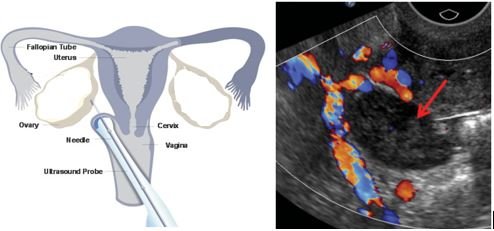Female Infertility
There are many biological causes (polycystic ovary/anovulatory/endometrial insufficiency) of infertility, including some that medical intervention can treat. Situations exist where multiple IVF had not worked, for reasons that cannot be elucidated by even the most sophisticated diagnostic methods and testing. Two main aetiologies of Female infertility can be successfully ovarian and endometrial rejuvenation via stem cells application has shown a great hope.
1. Anovulatory: lack of ova (anovualtory cycles) can be primary or secondary to diseases like polycystic ovary etc
Ovarian rejuvenation & stimulation via transvaginal administration of stem cells makes the local microenvironment in ovaries favourable thus helps in production of healthy and functional ova
Though the hypothesis exists that these pluripotent stem cells can differentiation into oocytes and could generate new egg cells BUT we believe that as of now this looks unlikely .further it has been seen that ova produced via this mechanism not functional.
2. Endometrial causes: leading to infertility are either nonspecific or secondary to diseases like Asherman syndrome, tuberculosis multiple abortions, D&C etc
MSCs tend to secrete antifibrotic, angiogenic, antiapoptotic, immune suppressive factors in a paracrine manner which promote the regeneration of the endometrial lining of the uterus
Stem cell application improves endometrial microenvironment( Endometrial rejuvenation) hence contributing towards promoting fertility and pregnancy in women esp. in Patients in whom the endometrial growth of the cells is poor even in response to the hormonal treatment.
How it is done
Patients are evaluated for hormone levels and prolactine .infectious genital disease, anatomical abnormalities of the genital tract as these issues if present need to be corrected first.
Patients advised to strictly avoid smoking, drug or alcohol consumption and have appositive life style
As a day care procedure 240 ml of Bone marrow and 100 ml of fat is aspirated and processed for stem cells isolation. 2 ml of stem cells processed as per GMP is injected either into
- Trans vaginal administration of cells in ovaries
- Into the feeding artery of ovaries and uterus
- Subendromertial administration in uterus
*along with multiple flushing of uterine wall with growth factors and platelet rich plasma

Ultrasonographic guided transvaginal administration of cells into ovaries
What to expect
- 55 percent of women have shown evidence of live pregnancy within 6 to 9 months after undergoing the complete treatment protocol.
- The endometrium grows up to 7 mm and pregnancy is achieved the embryo transfer in 50 % of caes .
- 90 % of patients experienced regular menstruation after the stem cell application
